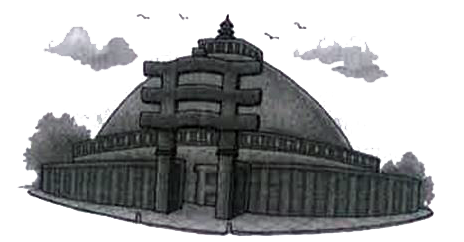To what extent does knowledge of Buddhist literature help in understanding the sculpture of Sanchi ?
(i) Several sculptures show the Buddha in human form instead they represented him by use of symbols each of which was related to pivotal aspect of his life .
(ii) The Stupa Mahaparinibban , the tree enlightenment for Buddha as per tradition attained enlightenment under the tree in Bodh Gaya.
(iii) The Wheel symbolised the Buddha preaciated his first sermon at Sarnath . The lotus spiritual growth. The elephant is associated with the story of the buddha.s birth and the horse came to represent renunciation.
(iv) The Jataka stories are a source for art historians to unravel some of the mysteries of the depiction of a rural scene art historians have identified is a story in stone.
(v) Literary tradition reflect some of the recurrent sculptures at Sanchi were perhaps not directly inspired by Buddhist ideas and folklore but by traditions . Pre- Buddhist as a beautiful woman swinging from the edge of the gateway is to inspired by popular tradition described in Sanskrit as Shalabhanjika .
(vi) Jatakas contain several animal stories that are depicted at Sanchi. According to popular traditions animals were often used to symbolise human attributes . Elephants were depicted to signify strength and wisdom.
(vii) The woman motif surrounded by lotuses and elephants which seem to be sprinkling water as abhisheka is identified by some historians as Maya , the mother of Buddha.
(viii) The knowledge of Buddhist literature has enabled art historians to delineate , understand and correlates the symbols, stories and popular traditions in the sculpture of Sanchi Stupa.
Topper's Solved these Questions
- THINKERS, BELIEFS AND BUILDINGS CULTURAL DEVELOPMENTSBOOK - FULL MARKSCHAPTER - THINKERS, BELIEFS AND BUILDINGS CULTURAL DEVELOPMENTSEXERCISE - NCERT TEXTBOOK QUESTIONS SOLVED (III Map Work)
1 Videos
- THINKERS, BELIEFS AND BUILDINGS CULTURAL DEVELOPMENTSBOOK - FULL MARKSCHAPTER - THINKERS, BELIEFS AND BUILDINGS CULTURAL DEVELOPMENTSEXERCISE - NCERT TEXTBOOK QUESTIONS SOLVED (IV. Project Work)
1 Videos
- THINKERS, BELIEFS AND BUILDINGS CULTURAL DEVELOPMENTSBOOK - FULL MARKSCHAPTER - THINKERS, BELIEFS AND BUILDINGS CULTURAL DEVELOPMENTSEXERCISE - PREVIOUS YEARS BOARD QUESTIONS SOLVED
21 Videos
- PEASANTS, ZAMINDARS AND THE STATE BOOK - FULL MARKSCHAPTER - PEASANTS, ZAMINDARS AND THE STATE EXERCISE - Previous years board questions solved
24 Videos
- THROUGH THE EYES OF TRAVELLERS BOOK - FULL MARKSCHAPTER - THROUGH THE EYES OF TRAVELLERS EXERCISE - PREVIOUS YEARS BOARD QUESTIONS SOLVED
17 Videos
Similar Questions
Knowledge Check
What does a Buddhist Stupa signify?
AIt is a place for Buddhists to meditateBIt is used to house bodily remains (teeth, bone or ashes) of the Buddha or his followersCA commemoration of a significant event of BuddhismDAll of the above
To what extent does globalisation provide opportunities as well as challenges?
View Solution(a) How does the study of fossils help to understand evolution.
View Solution(a) How does the study of fossils help to understand evolution.
View SolutionIn what ways does the concept of water potential help in explaining water movement?
View SolutionWhat does the root tip contain that helps in root elongation ?
View SolutionFollowing is a narrative on Sanchi stupa. Listen to it carefully and answer the questions that follow. You can listen to the recorded narrative or ask your teacher, sibling or friend to read it aloud.
The fascinating and world famous Sanchi stupa is located on a hilltop in Sanchi town, Madhya Pradesh, India. It is one of the most important Buddhist monuments that portrays Buddhist art and sculpture. Starting from the third century BC through the twelfth century AD, it attracts the attention of thousands of visitors round the year including national and foreign tourists, archaeologists, and historians among others. This stupa is the oldest stone structure in India that was built during the Mauryan period. Originally commissioned in the third century BCE by Emperor Ashoka, this huge hemispherical dome consists of a central chamber. In this chamber, the relics of Lord Buddha are placed. The original construction work of this stupa was supervised by Ashoka. His wife, Devi, was the daughter of a merchant of nearby village. Vidisha. Sanchi was also her birthplace as well as the venue of her and Ashoka's wedding. Later, four omamental gateways or toranas facing four directions and a balustrade surrounding the stupa were added in the first century BCE. The Great stupa at Sanchi is one of the oldest stone structures in India and counted among the best conserved ancient stupas of Central India. It has been enlisted as an UNESCO World Heritage Site since 1989.
The sculptures on the ornamental gateways or toranas consist of decorative illustrations of events encompassing the life of Lord Buddha. These events are explained in the Jataka tales. The tree used here symbolises Lord Buddha. The most striking features regarding the stupa is that Lord Buddha has been depicted symbolically by figures like thrones, wheels, and footprints among others.
Which Buddhist monument is referred to here and what does it portray?

View SolutionExplain hagiography of the Buddha which the art historians had to familiarize to understand Buddhist sculpture?
View Solution
